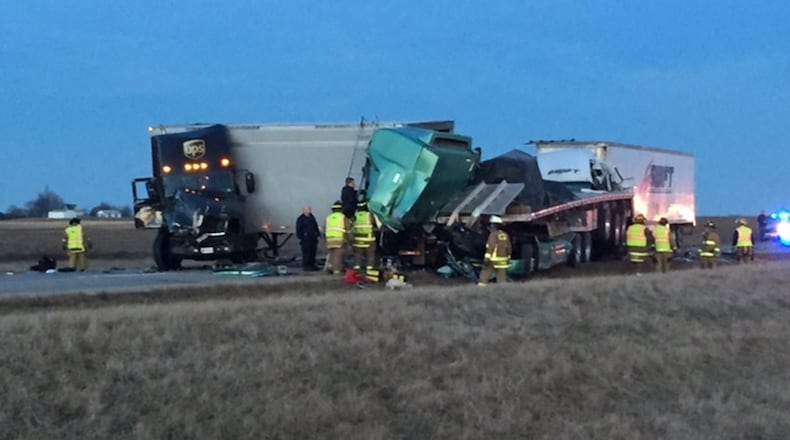Fatalities rose 6 percent in 2016, reaching an estimated 40,200 deaths compared to 37,757 deaths the previous year, according the council.
WHO'S RESPONSIBLE?: Large trucks get the blame, but car drivers cause majority of wrecks
The last time there were more than 40,000 fatalities in a single year was in 2007, just before the economy tanked, the AP said. There were 41,000 deaths that year.
There have been 91 fatal crashes on Ohio roads so far in 2017, according to the Ohio Highway Patrol. For all of 2016, there were 1,036 fatal crashes.
CONGESTION: Dayton highway intersection one of top truck bottlenecks in U.S.
The 2016 number was down slightly from 2015’s 1,029 fatal crashes in 2015, the patrol said.
However, 2015’s number was an increase from the number of fatal crashes in Ohio in 2014, which the patrol put at 919.
James Feddern, motor carrier enforcement manager for the OHP, said he hopes roads today are safer. But much of that depends on drivers, traffic volume and other factors, he said.
DANGEROUS HIGHWAYS: Fatal truck crash that kills son spurs father to action
“Traffic fatalities – a lot of it depends on weather and everything else, people’s disregard for other people on the highway,” he said.
“Hopefully, roads are getting less dangerous,” he added. “But you can’t account for people sometimes. I think traffic volume has increased.”
RELATED: High demand for truck drivers leads to new CDL training in Dayton
Kevin Burch, president of Dayton trucking firm Jet Express, said he isn’t surprised by the numbers.
“There are more cars and trucks on the road today than ever,” said Burch, who also serves as chairman of a national advocate for trucking, the American Trucking Associations. “You’ve got to look at those things.”
If you go back 10 years, there was less technology in cars, he said. Texting is a prime problem, in his view.
“If you really dive deep into those accidents, I think you’re going to find a lot of those drivers being on the telephone, texting while driving,” he said.
More cars and more distracting technology equal problems, he said.
“Those are some tough numbers,” Burch said. .
The national increase came as Americans drove more last year — a 3 percent increase in total miles, the AP reported. The council cited continued lower gasoline prices and an improving economy as key factors.
Americans have come to accept large numbers of traffic deaths as inevitable instead of taking actions that would prevent them, said Deborah Hersman, the council’s president.
“Motor vehicle fatality numbers have been ringing the alarm for two years,” she said. “Unfortunately, we have been tone-deaf to the data and the carnage on our roadways. If we fail to take action, the death toll will continue to rise.”
Jonathan Adkins, executive director of the Governors Highway Safety Association, which represents state highway safety offices, said state officials continue to point to three predominant factors in traffic deaths — “belts, booze and speed.”
In the last three years, 13 states have raised speed limits on at least some portion of their interstate highways.
“Additionally, driver distraction and our society’s addiction to electronic devices is likely playing a role in the increase in deaths,” Adkins said.
The estimated annual mileage death rate last year was 1.25 deaths per 100 million vehicle miles, an increase of 3 percent from the 2015 rate.
Traffic deaths began dropping in 2008 and reached their lowest point in six decades in 2011 at 32,000 deaths. They fluctuated slightly over the next two years, but started climbing in the last quarter of 2014.
As the economy recovered, people not only began driving more, but they also increased more risky types of driving “like going out on the weekends or taking long trips on unfamiliar roads,” said Adrian Lund, president of the Insurance Institute for Highway Safety.
Teens, who have the highest fatal crash rates, are also back on the road after the recession when many of them couldn’t afford to drive as much, he said.
The surge in fatalities comes as cars and trucks have more safety features than ever. Nearly all new cars and light trucks now have electronic stability control and rearview cameras, for example. Automakers are also beginning to equip more cars with sophisticated safety technology like adaptive cruise control, automatic emergency-braking and blind-spot monitoring that are designed to prevent crashes rather than merely make them survivable.
Other important safety advances are also on the horizon, including vehicle-to-vehicle communications that allow cars to wirelessly warn each other of their movements in time to avoid collisions and self-driving cars that hold the potential to eliminate human error, a factor in more than 90 percent of crashes.
The council’s fatality estimates differ slightly from those of the National Highway Traffic Safety Administration. The government counts only deaths that occur on public roads, while the council includes fatalities that occur in parking lots, driveways and private roads.
Last month, NHTSA reported that traffic deaths surged about 8 percent in the first nine months of 2016.
The Associated Press contributed to this story.
About the Author

